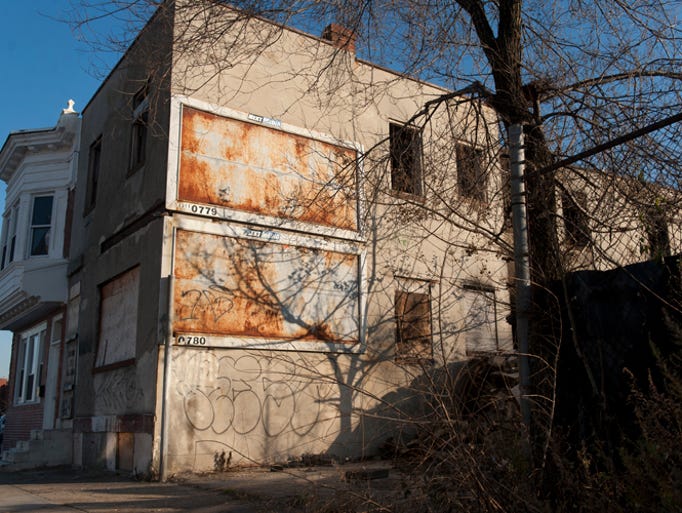For those who haven’t been following, Courier-Post reporter Kevin Shelly has been all over the Camden demolition project. I’ve been following it step-by-step, even having him come to speak to a class about the issue last year. There are a few reasons for that: 1) my work shows that community groups really care about blight 2) two of “my” students (PhD candidates in the department I teach in, though I have not had them for class) have been mentioned in Camden’s response to media inquiries. Blight in Camden is a big issue, and a complex one.
I’ve held off joining voices of criticism regarding the new demolition policies, and I hope this space can be a nuanced on that both gives credit where it’s due, and criticism where appropriate.
So let’s start with the good. It’s great to see the city administration creatively taking on an issue that really matters to residents. I went to a Camden Churches Organizing for People meeting in Cramer Hill, and blighted homes was the number one priority coming from residents. I’m happy to see the city finding a creative funding source (a fee levied on parking) to address a neighborhood need. That’s great, and I think the city deserves credit for it.

Photo by Denise Henhoeffer
There are some issues with the policy that merit pointing out. Shelly has pointed out how slow the contract bidding was to get sorted, it seems there were some mistakes there. But I want to focus on a few other things that are just now being discussed.
Shelly’s latest piece asks what will happen to salvageable homes. Essentially, there does not appear to be a plan that goes beyond demolitions. That’s a problem, but not one I want to criticize the city for too much. The pure number of abandoned and blighted properties makes it very difficult, given the resources available to the city, to come up with a comprehensive strategy. I don’t want to criticize triage as a strategy, I’m not sure the city has the capacity for much else.
I do think the city should have considered a mixed strategy of demolitions and (more expensive) rehab. Yes, there are properties that are facing immediate danger, and they need to be demolished, but there are also properties that with effective boarding up could retain value, and failing to address that will likely leave the city with more demolitions in another decade.
But again, the vast nature of the problem makes it hard to get too upset here. I’m not convinced that creating more empty lots in Camden does much in the long-term (there are already plenty), but there are so many structures that are dangerous that I feel like we should applaud an effort, even if I’d like to see a more balanced approach that tries to create more livable housing stock.
Another small issue with the current strategy is the decision to take out bonds against future revenues from the parking fee, making this a one-shot initiative. Again, the need here is great enough to justify this kind of logic, but it is ultimately unsustainable. By using future funds now, it makes it harder to create a long-term strategy, and easier for current politicians to take credit while leaving future politicians without a funding source to address the same issues. You can make the case that abandoned houses are so desperate right now to justify using future funds, but it’s also troubling; this initiative isn’t large enough to solve the problem, and borrowing against future revenues means hamstringing future administrations.
None of these small concerns is fatal, they just represent tradeoffs that policy-makers need to make when facing an overwhelming problem like this. The execution of the plan could be a more serious, and there are rumblings that folks aren’t receiving notice that they are on the demolition list. And, from what I hear, some neighborhoods aren’t thrilled with the idea of more vacant space. If this isn’t executed well, it could be a boondoggle, but the concept is relatively strong.
I do wish the city would be more forthcoming about these tradeoffs and tough decisions. Sometimes it feels like the city feels such pressure to show everything is getting better that it represents city success as a narrative it cannot deviate from. Rather than admit that this blight initiative is already stretching the city’s capacity and resources, it felt the need to make even bigger claims. In a Nov. 25th press release, the city intimated that Rutgers-Camden students were addressing salvageable properties.
Well, that’s true in the loosest sense (I know the students involved). But their project was small and Camden City was a small part of it. It certainly appears that the city, in its eagerness to show that it was addressing blight, used this student project inaccurately to create the impression Rutgers was involved in a widespread blight program. That couldn’t have been further from the case; this was two talented PhD candidates working on a project.
It’s a shame in this case, when the city is attempting to address a key resident concern, that it also feels so much pressure to be seen as having “solved” its problems that it has to misrepresent a partnership with Rutgers in order to keep up a fiction of a city that’s fixed. Those around Camden understand that progress comes in fits and starts, and surrounded by deep, almost intractable problems. Acknowledging that Camden’s problems can’t be fixed with a spate of demolitions, or a student project isn’t just honest, it’s the type of dialogue we should expect from a city administration that is connected to the world of its residents.